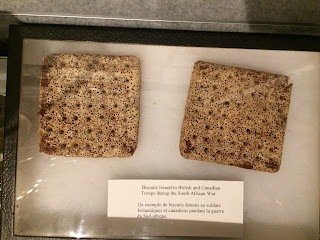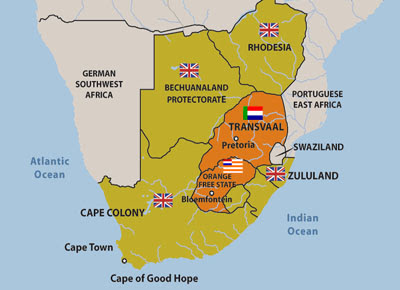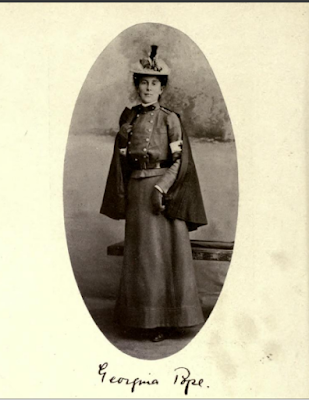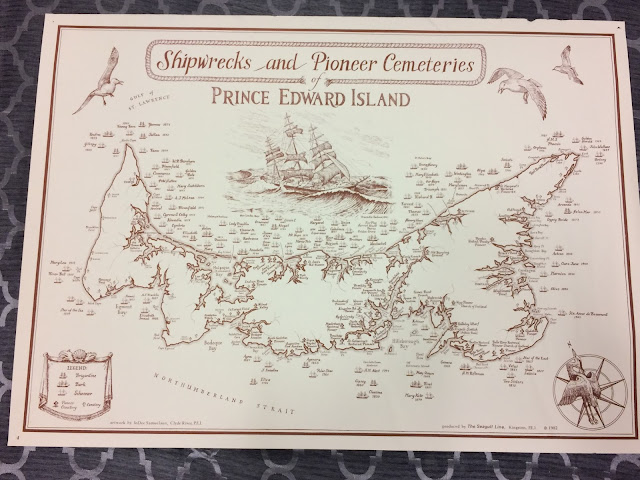Jawbreaker Biscuits: A Small Artefact Connecting PEI to the South African War
Sometimes the artefacts you find in museums are amazing. So this week, I want to take a look at one of the neat artefacts you can find at the PEI Regiment Museum- South African War biscuits, also known as hardtack biscuits. These biscuits are made from a simple recipe of flour, water, and sometimes salt. Yum! Although in all honesty, they have survived rather well.
One of the reasons artefacts, even small ones, are interesting is because they are connected to a much larger story (and sometimes, like these biscuits, the fact they still exist is amazing).
Prime Minister Wilfrid Laurier initially wanted to stay out of the conflict, but finally caved to public pressure and his government authorized a volunteer force of 1,000 men. Which grew to 7,500 volunteers by the end of the war.
The South African War was also the first time Canadian women served overseas. 12 Nursing Sisters went to South Africa, led by PEI's own Georgina Pope, who would become the first Canadian to be awarded the Royal Red Cross for her work!
If you want to make your own hardtack biscuits, mix 1/2 tablespoon of salt with a cup of water and add it to 5 cups of flour. Knead the dough and roll it out to about 3/8 inch thick. Cut into squares (about 3-inch squares), pierce with a fork, and bake at 400 until they are a light brown (about 30 minutes). If you do decide to make them, remember, First World War soldiers gound them into powder and in the United States, Union soldiers nicknamed them "jawbreakers".
One of the reasons artefacts, even small ones, are interesting is because they are connected to a much larger story (and sometimes, like these biscuits, the fact they still exist is amazing).
 |
| "Biscuits issued to British and Canadian troops during the South African War" Prince Edward Island Regiment Museum |
7,500 Canadians served in the war (soldiers and medical staff). Of that, 125 were Islanders. But, we also experienced casualties, such as Alfred Riggs and Roland Dennis Taylor.
 |
| Alfred Riggs and Roland Dennis Taylor, Islanders who died in the South African War. (Image Credit: Island Magazine) |
The South African War, AKA the Boer War, was the first time Canadian troops were officially dispatched overseas and lasted from October 1899 to May 1902. The origins of the war are complicated, so I am going to try to simplify it as much as I can.
The war was fought between Britain (and its colonies and dominions) against Transvaal and the Orange Free State, descendants of Protestant Dutch, German, and French refugees who migrated to the Cape of Good Hope in the 17th century. When the Cape of Good Hope was taken by the British, those who refused to submit to British rule migrated further inland and created Transvaal and the Orange Free State.
 |
| Boer War Map (Image Credit: Canadian War Museum) |
Britain was a strong colonizing power and wanted Transvaal... mainly they wanted the Transvaal gold fields... So they claimed the British and other foreign workers, or Uitlander as they were called, working in the Transvaal gold mines were being mistreated and demanded change. A change that would have included modifying their constitution to grant the foreign workers (but mainly the British ones) more political rights. Even Canada passed a resolution to support the Uitlander cause. The British started amassing troops in the region. Then, in October of 1899, realizing with the British gathering their troops that war was inevitable, the Boers (Transvaal and the Orange Free State) attacked the British in a preemptive strike.
The Boers had far fewer troops, about 88,00 versus 500,000. But held out well given the circumstances.
When Britain went to war, Canadians were divided. Non-British citizens (ie. French, non-British immigrants, etc.) did not want to join in on the war, but English Canadians, for the large part, wanted to support Britain. Queen Victoria's Diamond Jubilee was celebrated two years earlier in 1897 and English Canadians (and their newspapers) were still feeling very patriotic.
 |
| "Canadian infantrymen Engaging the Boers, 18 February 1900" (Image Credit: Canadian War Museum) |
The South African War was also the first time Canadian women served overseas. 12 Nursing Sisters went to South Africa, led by PEI's own Georgina Pope, who would become the first Canadian to be awarded the Royal Red Cross for her work!
 |
| Georgina Pope in her Boer War uniform, which she designed (1899). First Canadian to be awarded the Royal Red Cross. I doubt she was spared from eating the hardtack biscuits. |
Like all wars, there are dark parts beyond the unfortunate deaths of brave soldiers and nurses. The Boers were strong in guerilla warfare. The British responded to these tactics with a "scorched-earth" strategy - burning down farms and homes of civilian Boers and Africans and placing them in internment camps. A strategy Canadian troops helped with. The Boer War claimed an estimated 60,000 lives:
- 7,000 Boer soldiers
- 22,000 Imperial troops (297 Canadians are listed in the Canadian Virtual War Memorial)
- 7,000 to 12,000 African civilians
- 18,000 to 28,000 Boer civilians
Many of the civilians who died were women and children and died due to the conditions of the camps they were confined in. Although the strategy worked, Canadians and British at home were outraged.
So how do these biscuits tie-in with all this? These biscuits, seen below, were part of the rations provided to British and Canadian soldiers. Rations needed to be foods that could be produced and shipped to soldiers in mass amounts and quickly. Now if this is what they look like today, imagine what they would have tasted like in 1899.
 |
| Hardtack biscuits |
Hardtack biscuits were also issued during the First World War. To save their teeth and make the biscuits more edible, they would grind them down to powder, mix them with milk and/or jam, and heat it up a little when they could. Doesn't that sound tasty...
Linda Wheeler wrote about her experience making hardtack biscuits in the Washington Post. When they were fresh from the oven, she described them as"easily broken and tasted warm and bland" once they cooled, however, she said she "couldn't break it, and the taste was cold and bland." So if you do decide to make them, maybe consider scheduling a dentist appointment - when it comes to hardtack biscuits, it is an advantage we have that the soldiers of the South African and First World War did not have.
If you like my blog, please share and subscribe.
The PEI Regiment Museum is located at the Queen Charlotte Armoury, 3 Haviland Street in downtown Charlottetown.
Sources
"Books of Remembrance." Veterans Affairs Canada. http://www.veterans.gc.ca/eng/remembrance/memorials/books
"Canada and The South African War." Canadian War Museum. https://www.museedelaguerre.ca/cwm/exhibitions/boer/boerwarhistory_e.shtml
Duffet, Rachel. Biscuits for breakfast - trench warefare was hard on soldiers' teeth." Th Conversation. http://theconversation.com/biscuit-for-breakfast-trench-warfare-was-hard-on-soldiers-teeth-64457
MacKinnon, Darin and Boyde Beck. "Islanders and the Boer War." Island Magazine 26 (1989), 3-12.
Miller, Carman and Richard Foot. "Canada and The South African War." Canadian Encyclopedia. November 18, 2016. http://www.thecanadianencyclopedia.ca/en/article/south-african-war/
"South African War." Encyclopedia Britannica. https://www.britannica.com/event/South-African-War
Wheeler, Linda. "Hardtack is Easy to Make, Hard to Eat." Washington Post, 12 December 2004, PW08.


Comments
Post a Comment